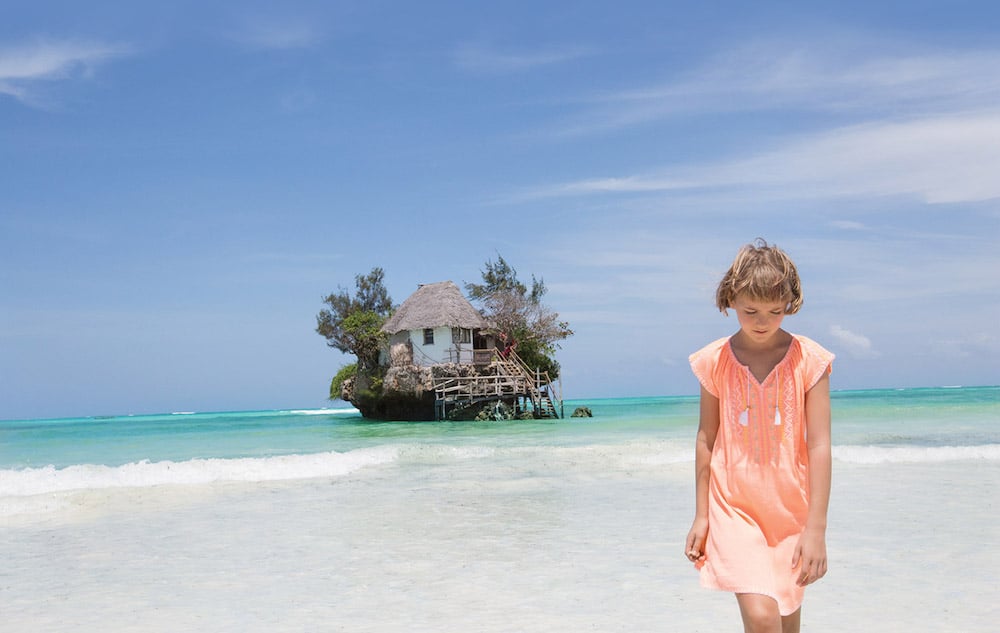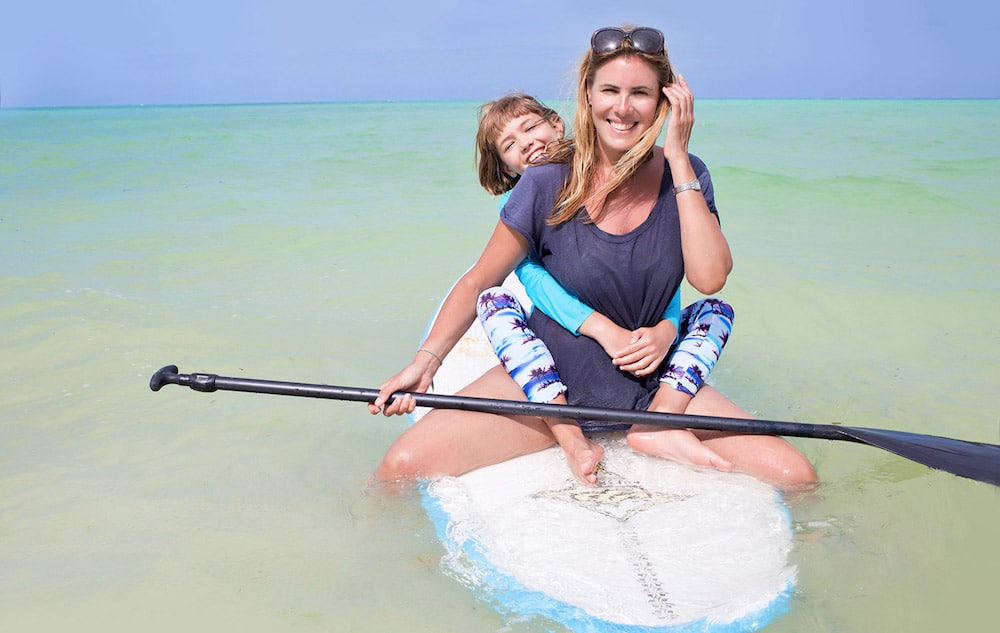Join Abi Campbell and her daughter on a far off journey to the breathtaking African island of Zanzibar for the trip of a lifetime.
Jemima and I had been in Zanzibar for three days when we hatched our business plan: to open a stylish coffee shop in Stone Town. We’d use the best African beans available and spike it with a kaleidoscope of locally grown island spices. We’d design and sell handcrafted jewelry at our in-house boutique. We shook on it. Now that Jemima, 11, and I had found paradise, we weren’t leaving. No way.

Sadly I’m writing this at 25,000 feet, en route home. Our grand plan didn’t pan out. No worries, though, because we made a pact. We’d find a way to come back — we just had a few commitments to tie up first. Ordinarily, I’m a control freak about planning travel itineraries, but on this occasion I tapped into one of the island’s most trusted operators, Xperience Tours. I decided that on a trip to a far-flung place like Zanzibar, it made sense to pass the logistics to a guide. Fadhil greeted us at the airport in a minivan and took us to the east coast, where we’d stay at a pair of hotels during our visit: the delightfully laid-back Breezes Beach Club and the White Sand Luxury Villas & Spa, which is devoted to style and sustainability. On the hour-long journey, Fadhil gave us a historical and cultural overview of Zanzibar. We agreed to meet the next day at a lazy noon to visit the Rock on Michanwi Pingwe beach.

The Rock is the sort of place you’d stumble upon in 1,000 Places to See Before You Die. A craggy outcropping positioned precariously in the azure sea, it doesn’t look real — and quirkier still, it’s home to a restaurant. When we disembarked from the tender, we were greeted by Nigel, the Rock’s eccentric English owner. We dined on African– Italian fusion cuisine and sat on the sun-bleached terrace, rubbing our eyes at the staggering beauty. Looking out on the Indian Ocean, Jemima suggested that this is what heaven must look like — and I agreed.
After lunch, we headed to a local village, where a man handed Jemima a green coconut and instructed her on how to remove the husk. A woman cracked the nut and showed how to extract the milk. Then an old woman with bony fingers spun the mangrove-marinated husk into raffia, later to be dyed and made into bags and baskets. The journey of this single natural resource was amazing: no waste, every part utilized. Zanzibar is known for its aromatic spices, hence its alias, the Spice Island. A spice tour is a must-do, and it’s about as eco-friendly as you can get. These are working farms, and there are no souvenir shops, just an open-sided hut with bags of harvested spices.

Our attention was caught by a voice high in the palm-tree canopy: “Jambo, jambo, bwana.” Jemima and I rushed over to see a pair of feet protruding from the leaves 70 feet above our heads. Coconuts rained down intermittently as the man cut them loose, then he nimbly shimmied down the trunk while belting out the Lion King classic “Hakuna Matata.” If there were a Zanzibar’s Got Talent, Jemima and I agreed he would be a firm contender.
On the tour, our host carved off a slice of bark and asked Jemima if she knew what it might be. She lifted the sample to her nose, and her face lit up as the aroma of her favorite pancake topping collided with her sensory receptors. Things continued in that vein, uncovering the natural source of cloves, vanilla, lemongrass, ginger and turmeric, alongside a narrative on their origin, uses and healing properties. As we walked, our guide fashioned every little girl’s dream collection of accessories out of pineapple leaves: a handbag, a pair of sunglasses, a majestic leaf and flower crown worthy of a real princess.
We headed to nearby Stone Town for lunch, and I asked Fadhil to take us to his favorite spot. Lukmaan Restaurant was a no-frills joint serving fresh juices and curries packed with all the spices we’d just sampled. Afterward, we wandered the warren of narrow alleyways on a treasure hunt for ancient Zanzibarian doors showcasing early Arabic and Indian architectural influences. Jemima played with kids on the street, and I sat on a timeworn doorstep, watching new friendships unfold.

In the weeks before our trip, Jemima and I were obsessively Googling images, going gaga over photos of wooden fishing dhows with their magnificent sails. Naturally, we jumped at the opportunity to take an excursion to the outlying island of Kwale. It was a choppy crossing on what felt like a tree trunk, but we were rewarded with a Robinson Crusoe–style lunch of grilled lobster and fruit on a sandbar. We snorkeled, then steered the boat into a hidden blue lagoon that resembled the forgotten world. Watching the sun disappear into the horizon as I sailed back with my intrepid daughter by my side was a near religious experience.
Zanzibar’s greatest seduction is its miles of spotless sand beaches fringed with turquoise sea. I’d go so far as to say it’s on par with the Maldives, but you don’t have the disadvantage of being stranded on a tiny atoll with no escape. There were times in the day when Jemima and I walked for yards into the ocean toward the reef and were still only waist-deep in glassy water with unblighted velvety-soft sand underfoot.

One day, we took a reef walk at low tide from Breezes hotel and picked our way across the ocean floor for an hour to where the waves broke. We saw sea sponges, urchins and bright crimson starfish. In the few hours that the sea retreated, it unveiled all the treasures and secrets of an alien world we humans barely know exists. Young children who cannot snorkel or dive will be amazed.
There is so much to see in this beautiful place, and with the help of Fadhil, we packed our days. We visited the spectacular Maruhubi Palace ruins. We ventured into Jozani Chwaka Bay National Park to track down colobus monkeys. We explored the mangrove swamps.
Our overriding memory of Zanzibar will not be of beaches and nature and attractions, though, but of the people we met while we were there. Jemima and I returned home from our trip feeling emotionally invested in one particular community, where we visited a local school that was severely underfunded.

We later set up a charity that raised almost $3,000 to build a new classroom for the children we met. Next year, when the project is completed, we have been invited to go back to see it. So we may be returning sooner than we thought. Perhaps our little coffee shop in paradise isn’t a pipe dream after all.
The Lowdown
Getting Here: Zanzibar is located in the Indian Ocean off the coast of Tanzania. There are no direct flights from the U.S. to Zanzibar, but you can fly to Zanzibar via Istanbul (Turkish Airlines) or Doha (Qatar Airways). Or you can fly into the largest city in Tanzania, Dar es Salaam, and take a small plane or a ferry.
Where to Stay: Breezes Beach Club; White Sand Luxury Villas & Spa
Where to Eat & Drink: Lukmaan Restaurant; The Rock Restaurant

